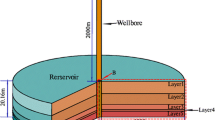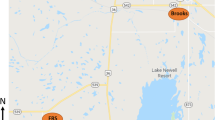Abstract
Simulations of CO2 injection into confined saline aquifers were conducted for both vertical and horizontal injection wells. The metrics used in quantifying the performances of different injection scenarios included changes in pressure near the injection well, mass of CO2 dissolved into brine (solubility trapping), and storage efficiency, all evaluated with an assumed injection period of 50 years. Metrics were quantified as functions of well length, well orientation, CO2 injection rate, and formation anisotropy (ratio of vertical to horizontal conductivity). When equal well lengths are compared, there is not a significant difference between the predicted performances of horizontal and vertical wells. However, the length of a horizontal well may exceed the length of a vertical well because the length of the horizontal well is not constrained to the vertical thickness of the geologic formation. Simulations show that, as the length of the horizontal well is allowed to increase, the geologic formation can receive a significantly higher CO2 injection rate without exceeding a maximum allowable pressure. This result is observed in both isotropic and anisotropic formations, and suggests that horizontal wells may be advantageous under pressure-limited conditions. However, the use of horizontal wells does not significantly improve the storage efficiency, and under strongly anisotropic conditions, a vertical well provides higher storage efficiency than a horizontal well. We conclude that horizontal wells may be preferable if the goal is to sequester a large amount of CO2 in a short period of time, but do not offer a significant advantage in terms of long-term capacity of a potential repository.
Similar content being viewed by others
References
Bachu S.: Sequestration of CO2 in geological media: criteria and approach for site selection in response to climate change. Energy Convers. Manag. 41, 953–970 (2000)
Bachu S., Adams J.J.: Sequestration of CO2 in geological media in response to climate change: capacity of deep saline aquifers to sequester CO2 in solution. Energy Convers. Manag. 44, 3151–3175 (2003)
Bachu S., Bonijoly D., Bradshaw J., Burruss R., Holloway S., Christensen N.P., Mathiassen O.M.: CO2 storage capacity estimation: methodology and gaps. Int. J. Greenh. Gas Control 1, 430–443 (2007)
Bradshaw J., Bachu S., Bonijoly D., Burruss R., Holloway S., Christensen N.P., Mathiassen O.M.: CO2 storage capacity estimation: issues and development of standards. Int. J. Greenh. Gas Control 1, 62–68 (2007)
Bruant R.G., Guswa A.J., Celia M.A., Peters C.A.: Safe storage of CO2 in deep saline aquifers. Environ. Sci. Technol. 36(11), 240A–245A (2002)
Corey A.: The interrelation between gas and oil relative permeabilities. Prod. Mon. 19, 38–41 (1954)
Denney D.: Continuous improvement led to the longest horizontal well. J. Pet. Technol. (JPT) 61, 55–56 (2009)
Gupta N., Sass B., Chattopadhyay S., Sminchak J., Wang P., Espie T.: Geologic storage of CO2 from refining and chemical facilities in the midwestern US. Energy 29, 1599–1609 (2004)
Holloway S.: Storage of fossil-fuel-derived carbon dioxide beneath the surface of the earth. Ann. Rev. Energy Environ. 26, 145–166 (2001)
Intergovernmental Panel on Climate Change (IPCC): IPCC Special Report on Carbon Dioxide Capture and Storage, prepared by Working Group III of the Intergovernmental Panel on Climate Change. Cambridge University Press, Cambridge, United Kingdom, and New York, NY (2005)
Jikich, S.A., Sams, W.N., Bromhal, G., Pope, G., Gupta, N., Smith, D.H.: Carbon dioxide injectivity in brine reservoirs using horizontal wells. Presented at the second annual conference on carbon sequestration, developing & validating the technology base to reduce carbon intensity, Alexandria, Virginia, 5–8 May 2003. http://www.netl.doe.gov/publications/proceedings/03/carbon-seq/PDFs/107.pdf
Joshi S.D.: Horizontal Well Technology. PennWell Publishing Company, Tulsa, OK (1991)
Koide H., Tazaki Y., Noguchi Y., Nakayama S., Iijima M., Ito K., Shindo Y.: Subterranean containment and long-term storage of carbon dioxide in unused aquifers and in depleted natural-gas reservoirs. Energy Convers. Manag. 33, 619–626 (1992)
Kopp A., Class H., Helmig R.: Investigations on CO2 storage capacity in saline aquifers, Part 2: estimation of storage capacity coefficients. Int. J. Greenh. Gas Control 3, 277–287 (2009)
Nordbotten J.M., Celia M.A., Bachu S.: Injection and storage of CO2 in deep saline aquifers: analytical solution for CO2 plume evolution during injection. Transp. Porous Med. 58, 339–360 (2005)
Okwen, R.T.: Enhanced CO2 storage in confined geologic formations. Ph.D. dissertation, University of South Florida, Tampa, FL (2009)
Okwen R.T., Stewart M.T., Cunningham J.A.: Analytical solution for estimating storage efficiency of geologic sequestration of CO2. Int. J. Greenh. Gas Control 4, 102–107 (2010)
Ozah, R., Lakshminarasimhan, G., Sepehrnoori, K., Bryant, S.: Numerical simulation of the storage of pure CO2 and CO2–H2S gas mixtures in deep saline aquifers. SPE 97255, In: Proceedings of the SPE Annual Technical Conference and Exhibition, Dallas, TX, 9–12 October 2005
Pruess K., Garcia J.: Multi-phase flow dynamics during CO2 disposal into saline aquifers. Environ. Geol. 42, 282–295 (2002)
Pruess K., Spycher N.: ECO2N—a fluid property module for the TOUGH2 code for studies of CO2 storage in saline aquifers. Energy Convers. Manag. 48, 1761–1767 (2007)
Pruess K., Oldenburg C., Moridis G.: TOUGH2 User’s Guide, Version 2.0. Lawrence Berkeley National Laboratory report LBNL-43134, Berkeley, CA (1999)
Pruess K., García J., Kovscek T., Oldenburg C., Rutqvist J., Steefel C., Xu T.: Code intercomparison builds confidence in numerical simulation models for geologic disposal of CO2. Energy 29, 1431–1444 (2004)
van der Meer L.G.H.: Investigations regarding the storage of carbon dioxide in aquifers in the Netherlands. Energy Convers. Manag. 33, 611–618 (1992)
van der Meer L.G.H.: The conditions limiting CO2 storage in aquifers. Energy Convers. Manag. 34, 959–966 (1993)
van der Meer L.G.H.: CO2 storage efficiency of aquifers. Energy Convers. Manag. 36, 513–518 (1995)
van Genucthen M.Th.: A closed-form equation for predicting the hydraulic conductivity of unsaturated soils. Soil Sci. Soc. Am. J. 44, 892–898 (1980)
White C.M., Strazisar B.R., Granite E.J., Hoffman J.S., Pennline H.W.: Separation and capture of CO2 from large stationary sources and sequestration in geological formations: coalbeds and deep saline aquifers. J. Air Waste Manag. Assoc. 53, 645–715 (2003)
Author information
Authors and Affiliations
Corresponding author
Rights and permissions
About this article
Cite this article
Okwen, R., Stewart, M. & Cunningham, J. Effect of Well Orientation (Vertical vs. Horizontal) and Well Length on the Injection of CO2 in Deep Saline Aquifers. Transp Porous Med 90, 219–232 (2011). https://doi.org/10.1007/s11242-010-9686-5
Received:
Accepted:
Published:
Issue Date:
DOI: https://doi.org/10.1007/s11242-010-9686-5




